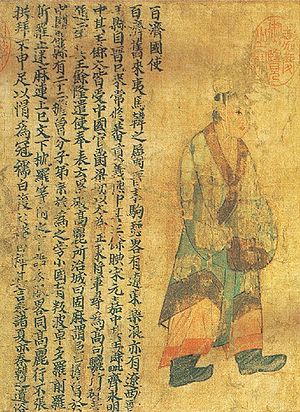Baekje was founded by Onjo, the third son of Goguryeo's founder Jumong and So Seo-no, at Wiryeseong (present-day southern Seoul). Baekje, like Goguryeo, claimed to succeed Buyeo, a state established in present-day Manchuria around the time of Gojoseon's fall.
Baekje alternately battled and allied with Goguryeo and Silla as the three kingdoms expanded control over the peninsula. At its peak in the 4th century, Baekje controlled most of the western Korean peninsula, as far north as Pyongyang, and may have even held territories in China, such as in Liaoxi, though this is controversial. It became a significant regional sea power, with political and trade relations with China and Japan.
In 660, it was defeated by an alliance of Silla and Chinese Tang Dynasty, submitting to Unified Silla.
History
Expansion
During the reign of King Goi (234–286), Baekje became a full-fledged kingdom, as it continued consolidating the Mahan confederacy. In 249, according to the ancient Japanese text Nihonshoki, Baekje's expansion reached the Gaya confederacy to its east, around the Nakdong River valley. Baekje is first described in Chinese records as a kingdom in 345. The first diplomatic missions from Baekje reached Japan around 367 (According to the Nihon Shoki : 247).King Geunchogo (346–375) expanded Baekje's territory to the north through war against Goguryeo, while annexing the remaining Mahan societies in the south. During Geunchogo's reign, the territories of Baekje included most of the western Korean Peninsula (except the two Pyeongan provinces), and in 371, Baekje defeated Goguryeo at Pyongyang. Baekje continued substantial trade with Goguryeo, and actively adopted Chinese culture and technology. Buddhism became the official state religion in 384.
Baekje also became a sea power and continued mutual goodwill relationships with the Japanese rulers of the Kofun period, transmitting continental cultural influences to Japan. The Chinese writing system, Buddhism, advanced pottery, ceremonial burial, and other aspects of culture were introduced by aristocrats, artisans, scholars, and monks throughout their relationship.
During this period, the Han River basin remained the heartland of the country.
Ungjin period
In the 5th century, Baekje retreated under the southward military threat of Goguryeo, and in 475, the Seoul region fell to Goguryeo. Baekje's capital was located at Ungjin (present-day Gongju) from 475 to 538.Isolated in mountainous terrain, the new capital was secure against the north but also disconnected from the outside world. It was closer to Silla than Wiryeseong had been, however, and a military alliance was forged between Silla and Baekje against Goguryeo.
Most maps of the Three Kingdoms period show Baekje occupying the Chungcheong and Jeolla provinces, the core of the country in the Ungjin and Sabi periods, although at some points in time, Baekje controlled territory in China that ringed the Bohai Sea.
Sabi period
In 538, King Seong moved the capital to Sabi (present-day Buyeo County), and rebuilt his kingdom into a strong state. From this time, the official name of the country was Nambuyeo ("Southern Buyeo"), a reference to Buyeo to which Baekje traced its origins. The Sabi Period witnessed the flowering of Baekje culture, alongside the growth of Buddhism.Under pressure from Goguryeo to the north and Silla to the east, Seong sought to strengthen Baekje's relationship with China. The location of Sabi, on the navigable Geum River, made contact with China much easier, and both trade and diplomacy flourished during his reign and continuing on into the 7th century.
In the 7th century, with the growing influence of Silla in the southern and central Korean peninsula, Baekje began its decline.
Foreign relations
Relations with China
In 372, King Geunchogo paid tribute to the Jin Dynasty of China, located in the basin of the Yangtze River. After the fall of Jin and the establishment of Song Dynasty in 420, Baekje sent envoys seeking cultural goods and technologies.Baekje sent an envoy to Northern Wei of Northern Dynasties for the first time in 472, and King Gaero asked for military aid to attack Goguryeo. Kings Muryeong and Seong sent envoys to Liang several times and received titles of nobility.
Tomb of King Muryeong is built with bricks according with Liang's tomb style.


댓글 없음:
댓글 쓰기